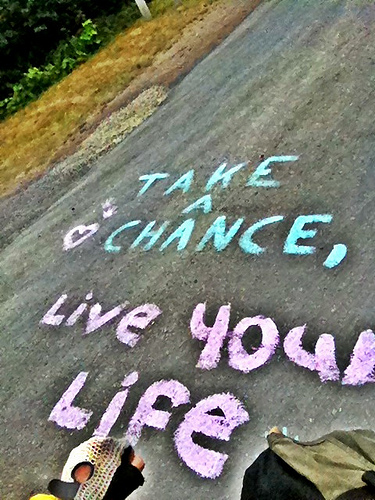Down the Pacific Coast by Brompton
Now that it’s icy in Portland, I suppose it’s time to reminisce on August. I spent the best two weeks of my life thus far riding my trusty Brompton folding bike, lightly modified, about 700 miles down the Pacific coast this summer, nearly to San Francisco.
I rode alone, carrying full camping gear. I even did the extra-tough and remote Lost Coast segment. Yes, on 16″ wheels that many observers suppose are good for little more than scooting along the sidewalk to and from transit stops. Or maybe if you have a boat or something. The fact is, Bromptons are amazingly versatile, appealing to hardened bike geeks like me, as well as to … well, all kinds of people.
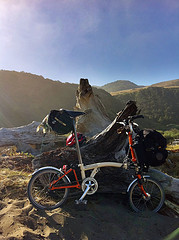
I came back from the trip feeling transformed, reborn even, and determined to write about it, but the reasons I had such an amazing time are so deeply personal that I’m shy of expressing too much publicly, as if this were (still) my over-sharing hippy personal blog. The first four days were great, but after the fifth day, perma-grin set in, punctuated only by a few moments daily of happy tears. I touched the wire that powers everything. I’ve had to assure some people with whom I’ve shared details that I was not on drugs, and I’ve choked up a few times in the telling. That kind of good.
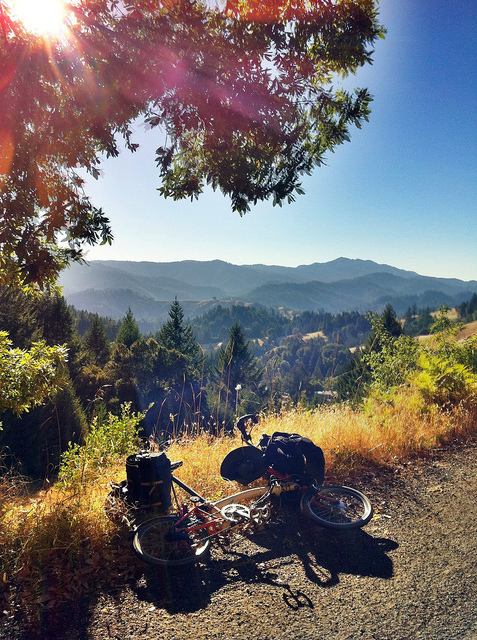
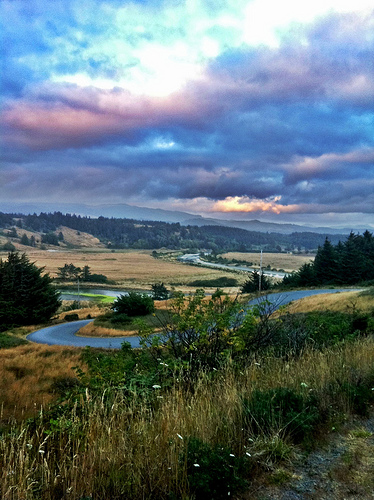
I’ll spare you the woo-woo parts (mostly). I think even the bare externalities of the ride are worth documenting: what I rode, what I took, highlights of the route, etc. It worked too well not to share!
The Bike and Its Enhancements
I rode my 2008 Brompton M6L. In Brompton-speak, that means the popular “M” type handlebar, 6 speeds, and no rear rack. This is, incidentally, by far the most common Brompton configuration we sell.
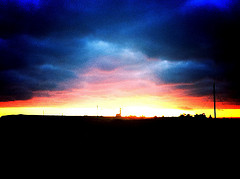
The M-type handlebars permit use of the large Touring Pannier, alias T-bag, which fixes to the frame (not the fork!) above the front wheel. This single bag was nearly large enough to hold all my stuff. Bearing big loads low in front damps the otherwise fluffy front-end feel of Bromptons (<30mm trail, for steering geeks). It feels more and more stolid as your load grows. It’s also a timesaver to have one’s stuff centered easily in a single large compartment, in hand’s reach even underway. Big load tip: pass the bag’s top strap behind the steering column for no wobbles. The M-type bars also accept clamp-on grips with bar end extensions for more hand positions from upright to aero. I used, and heartily recommend Ergon GC3s. Unlike the “P” type bars touted for touring, these support the wrists-in grip I require. All these months later I still haven’t taken them off, even though I don’t need the extra hand positions for in-town riding, and they impede a complete fold unless loosened and rotated first.
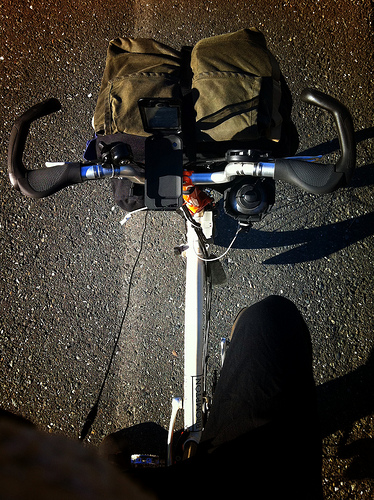
I upgraded from the original 6-speed gearing to the current 302% Brompton Wide Range (BWR) type. Until just last year, getting adequately low and wide-range gearing on a Brompton ideal for hilly unsupported touring was an expensive and fiddly proposition, sometimes entailing irreversible frame modifications. Now it’s easy, and I expect that more and more stories like mine will appear as other bike tourists do the new math. I replaced the stock 50T crank with a Sugino XD having 44 and 36T rings, making my ride a 12-speed having about a 24-85″ gear range. As I shifted among front rings (manually!) probably less than a dozen times the whole trip, even this modification wasn’t strictly necessary.
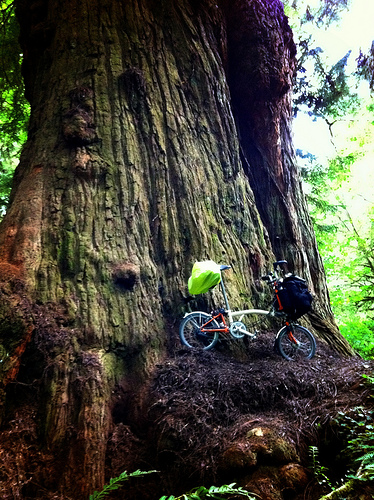
No rear rack! The T-bag was nearly big enough. I carried the surplus — my entire shelter and sleeping arrangement and a few tools — in an old waxed canvas Carradice Lowsaddle Longflap transverse saddlebag. I used guy lines between the outer bag loops and the rear fender roller to prevent the bag from swaying. Benefits of this approach versus a rear rack and bag system are that the bike can be parked and even completely folded without removing the load, and that the load is isolated by the bike’s simple rear suspension, just like the rider, for smoother carriage and maybe even a little less rolling resistance.(Please note that Brompton does not endorse carrying big loads in a saddlebag like this, especially if the rider is anywhere near the maximum weight or height, or the saddle is positioned far rearward, as the resulting extra leverage can lead to very bad things happening.)
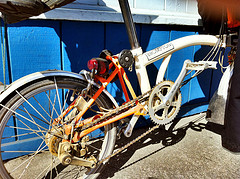
I have a hub dynamo powering front and rear LED lights. I ran with them on even in the day, most of the way, as the front is bright enough to be seen a mile away in daylight, LEDs won’t likely burn out in my lifetime, and drag is not noticeable. What’s more, I used a Biologic Reecharge to keep my iPhone charged from the dynamo. The phone did semi-constant duty as iPod, still and video camera, GPS, and internet device, providing invaluable information countless times. I tweeted several times a day to stay in touch, even video panda tweets. There can be no loneliness in the shimmering maw of the twitterverse! I also made a phone call or two. It worked well, though I could discharge the device faster than the hub could recharge it if I used no discipline with the internet features in the many weak-signal areas.
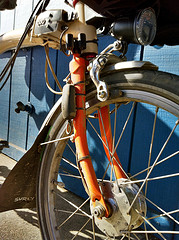
I used MKS Lambda platform pedals fitted with the “Ezy” quick-release system so the bike still folds as small as with the stock folding pedal. No straps or cleats: just pedals and boots, and I survived! I also rode with a new Brooks B17 saddle and no sort of padded or specially lined pants: zero butt pain. I know, I was doing it all wrong!
I had no notable mechanical problems. One normal flat, which I patched. One tire wore through in a long panic skid to avoid a cattle guard: replaced it; little wheels mean little spares! Bearing cones went loose at one point affecting shifting: easy fix; my bad for letting it happen. Everything else: flawless.
The number one question asked along the way was “why are you riding that?” as if obviously it were a poor choice. Even I suspected in advance that there would be times I’d regret this choice, in defiance of so much conventional wisdom. I admit also that I enjoy doing things differently for its own sake, but the plain truth is that I made better time with this setup, in greater comfort, than I did almost exactly 10 years prior on this route riding a lavishly appointed custom touring bike. I was in better shape then, too. I will tour this way again without hesitation. The diminutive unlikeliness of the bike helps remind you that touring isn’t about the equipment: you yourself are flying!
It is true that little wheels don’t handle poor surfaces as well as larger. More caution than usual is required to negotiate potholes and the like. Loose gravel at speed is sketchy on almost any bike, and it’s a small wonder I never crashed on any of it. On certain very steep, very long and twisty descents, braking friction caused the little rims to overheat. The big upside of little wheels, apart from letting you take your folded bike almost anywhere, and being out of the way of a big front central frame-fixed bag, is that they are quite light and very strong. Even running tough 37mm tires, they accelerate snappily like race wheels, especially welcome when climbing with a load. I think the small inertia of the wheels helped spare my knees the pain that has been part of longer rides all my life.
Ultimately, I chose the Brompton from a stable including two excellent but long-idle “real” touring bikes because I ride it several times a week year round. I know it best; trust it most. I can tell the difference between its normal occasional squeaks and rattles, and real problems. I’ve never ridden a bike for long that I didn’t develop an irrational attachment to, but ever since this ride, I’ve wanted to feed my Brommie buckets of apples.
The Route
The Pacific Coast Bicycle Route is well-signed and documented in books and maps. I followed the route for the most part. I’ve ridden this way before. I like novelty and exploration generally, so considered a new route, but inner exploration was higher on my list this time, and I can’t imagine a more beautiful course than this. It follows US 101 most of the way into California, which is much more pleasant than it sounds, with a broad shoulder in most parts, absolutely spectacular views, and lots of bike-friendly camping choices along the way. I spent only two nights in the same campgrounds as when I rode this way before, for instance. Prevailing winds are from the north in fair weather. What’s more, riding north to south means that climbs tend to be on the more heavily shaded north slopes of the hills.
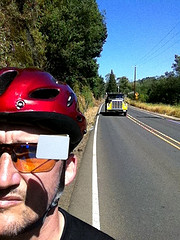
Parts of the route have narrow shoulders, and there can be a lot of RV and logging traffic. A rear view mirror is essential. Paradoxically, perhaps, I found that listening to music made riding with highway traffic more relaxing. Without music, the wind and constant motor buzz makes it hard to filter the noise from signal of threat: it’s exhausting. With music, you come to rely more on your mirror to scan behind on the highway’s usually long sightlines. Close comers get through the music in plenty of time anyway. Humans make ugly noises and beautiful sounds. Nobody can hear you singing. I sang a lot, digging deep into the music, rediscovering it, with no worries about batteries thanks to the dynamo.
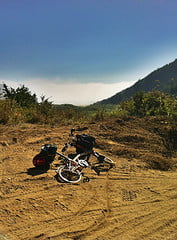
Getting to the route from Portland, I took MAX light rail to Hillsboro, and rode over the coast range at Carlton, camping just past the summit the first night. The real summit, not the many false ones. The next morning is a downhill delight along the peaceful Nestucca river. The first day’s climbing can be a shock, but know that it’s the toughest within several days’ ride, and you’ll be stronger by the time you find worse.
What Were Your Favorite Parts? Tell Us Stories.
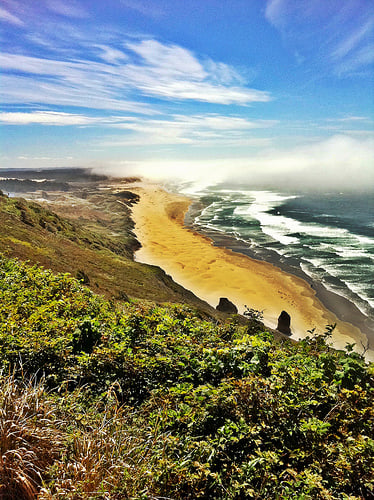
My favorite parts involved an episode of clairvoyance, vivid wakeful visions of luminous trees and translucent flowing asphalt, out-of-body awareness, a phantom gatekeeper in an overwhelming confluence of hints and almost trite symbolic elements indicating that I had died, recurrence of a beautiful lucid dream, accompaniment by and death of a smiling dragonfly whose body I bore to the beach below Mt. Tamalpais, sharply focused rolling meditative states, feats of effortless strength. It changed me. I’m still learning how, but it’s all good.
Most of this out-there stuff had already transpired before I reached the Lost Coast, the last three days of my ride. Deemed an alternate of the official route, I took a non-official variant of it. I had never been here before. This is the part of California that the coastal highway engineers gave up on, as just too ruggedly treacherous to traverse. What roads there are are very poor. It’s “lost” because civilization routed around it. No phone service; not much in the way of any other services either. Drink from streams. Bears and territorial clandestine cannabis growers. Brutally steep grades, and a southern exit through the 30 miles of loose rutted clay, rocks, roots and powdery dirt of Usal Road, often impassable in the wet season. I was feeling pretty invincible when I decided to go in there. I wanted to test my limits. The three days I spent inside were the tour within the tour, the inner sanctum, the secret garden.
In Ferndale, the last town before entering the Lost Coast, a roadie in pink kit rode up alongside and asked where I was heading. I told him, and his eyes popped. He shook his head, and he said declarrogatively “you really want to do that.” I told him I expected to hike a lot. “Yes, you will.” After lunching on a truly outstanding local grass-fed hamburger before the final turn, I thanked the cook. He said “Thanks, I hope you come back!” … “You mean, alive?” I didn’t know it then, but lunchtime was already too late to be leaving.
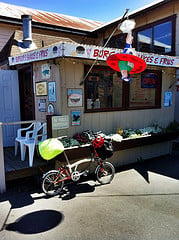
The steeps come immediately out of Ferndale. Cursing your mother affectionately, “give me strength,” and pushing the bike, I swapped the helmet for a wet hankie around my neck and floppy hat. I admired immediately the deep peaceful silence of the place, and left the music off. The ecotrope mixes elements from much further south and north: southern slopes like Mt. Diablo east of San Francisco; north like the Siuslaw five days north. From the top of the first ridge, you can see the curvature of the earth on the shining sea. I entered an almost dreamlike state as the day reclined, lulled into trance by the profound quiet, beauty, light, heat, and exertion.
Coming to the bottom of a valley, a scrawny black feral dog appeared at the side of the road with a little black boar as an unlikely pal, tusks visible. They positioned themselves on either side of the road and prepared to rush me, advancing slowly, heads low. Without plan, hesitation, or understanding why, I began yelling at them wildly in bad Spanish as I charged into their gap. “¡Pobrecitos! ¿Que pasó? ¿Donde es su mamá?” They froze, then shrunk back as I kept yelling, standing on the pedals in a sprint past. Crazy gringo kung fu bluff!
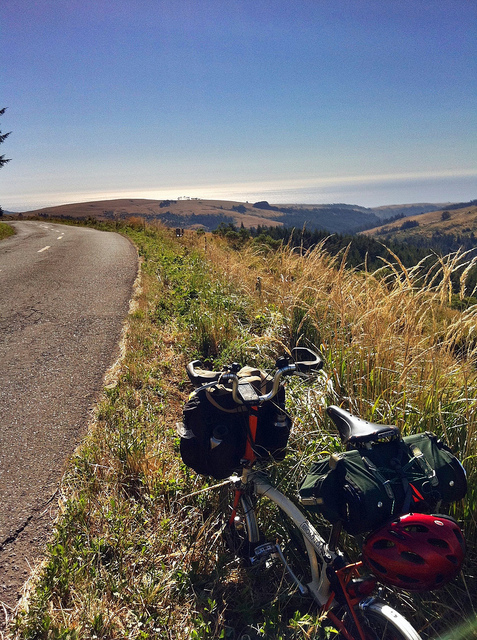
Not far beyond a few vacant ranch buildings optimistically called Capetown, a jeep passed me late in the afternoon. It stopped a quarter mile ahead, then reversed down a couple switchbacks to me. She asked if I was OK. “Best day of my life, thanks! But, um, I could use some water. I’m nearly out.” She didn’t have more than a few sips of juice, and she assured me that I wouldn’t be refilling from any stream in August before Petrolia, many more steep miles distant. She offered a ride. I hesitated, because I was invincible, right? No water. I accepted. Bike folded neatly in the crowded back seat. Brompton +1.
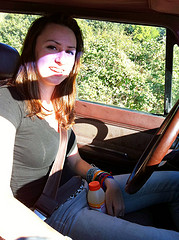
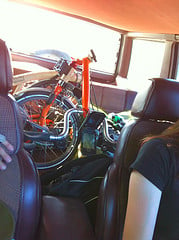
As she drove at crazy speed over the miles, I saw where I would have run dry, where I would have become desperate, where darkness would fall, where I’d pitch a miserable dry camp, and how much farther still I’d need to go in the morning to find water. Already flush with gratitude for the day, my thanks spilled over for what would not be, for her kindness. If she wasn’t saving my life, it was close enough. Thank you cool jeep lady!
Note: when entering the Lost Coast from the north, leave Ferndale early, carrying all the water you need for a full day of hard effort.
That night, well-watered, I strung my hammock on the driftwood at Mattole beach under a moonless clear sky. I marveled at the closeness of the milky way, the profusion of shooting stars, and I saw the zodiacal light.
At sunrise, I walked a mandala-esque labyrinth of stones on the beach sipping tea as the mists burned off. Among other things I noted how jeep lady, who could have been my daughter, had so gently punctured my prideful reluctance to receive help, and how this same pride, the equivalent inverse of shame, diminishes me in other ways.
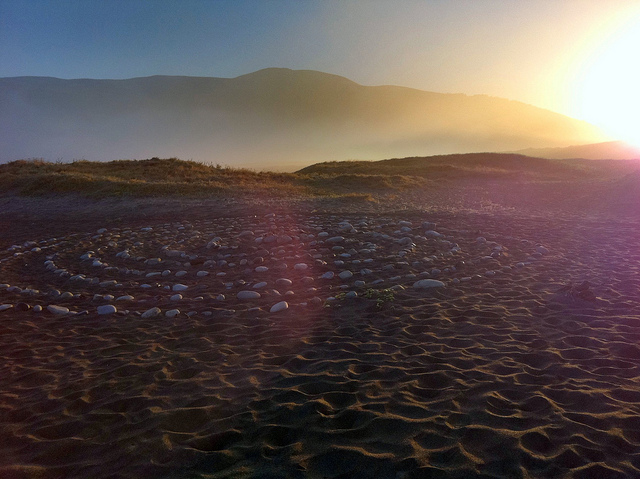
After a second breakfast of honey-sweet blackberries while talking to friendly cows about presence in the moment, exalting in the breadth of the moment, I made my way to the sleepy little store at Honeydew. There was no melon, but some well-tattooed and pierced locals were handing puppies out of a box on the porch. I asked the storekeeper about my map, whether being 15 years old it was still accurate. She laughed and said “nothing ever happens here.” I asked whether she thought I could make it over Wilder Ridge Road to a campground near the base of Usal Road before nightfall, or take the easier exit east to rejoin 101. She asked how I was feeling. “If I die today, I will be grateful for everything.” “Oh, that’s nice. Take Wilder Ridge.”
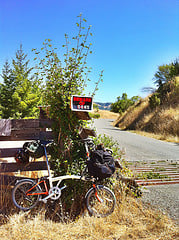
It was 90F on the shaded porch at the store. Soon, pushing up an unshaded slope, I was overtaken by a massive semi truck hauling a bulldozer, grinding away in first gear. Minutes later I heard a huge racket of metal on metal, and I beheld the spectacle of the bulldozer, having been unloaded, pushing the semi up an even steeper dirt section of the road. I drank 4.5 liters of water in less than 20 miles, when crusty and stinging with salt, no pee, I refilled from the stream at Ettersburg. In the Lost Coast, it seems any building larger than a house qualifies for a place name.
Coming down, the road was so twisty, and the surface so poor that it was seldom safe to let gravity have its way. There was no space between riding too fast and riding the brakes too hard. The 16″ rims can’t absorb as much heat in braking as larger ones. They fade and make horrible noises with a burning smell, threatening to blow the tires off. Slow pushing uphill, slow walking downhill. Growing impatient, at one point I saw what looked like about 200 yards of clear pavement, and I let fly. I had accelerated rapidly to about 40mph, when I spied a cattle guard in my path, with a twist right after it. The bars were spaced at least 8 inches apart — the radius of my wheels. Hit slow and I’d crash right there; hit fast and I’d crash on the twist beyond. So I braked in a panic, thrusting body back, but still locking up the rear wheel into a long, long skid. I stopped about a foot before the guard, heart pounding. The tire had worn down to the kevlar casing, fraying it. I replaced it and carried on, pushing when in doubt.
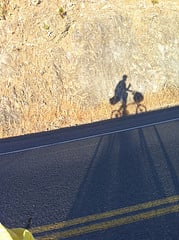
Late in the day, the road turned uphill yet again to the ridge above Shelter Cove. Alternately spinning and walking up, very tired, I deliberated whether to hitch a ride from a passing vehicle. About a third of them left a pungent waft of marijuana in their wake. I reached the top before making up my mind. Downhill again, and hurrying against the light, the wheels yet again began to overheat as I braked my way through the twists. Here I remembered a story about how riders in the Alps would cool their rims. I stopped and peed on their tiny angry hotness. TSSSCCHHHHHHSSSSSsssssssss TSSSCCHHSSSsssss TSSCCHHSSssssssss! I ran dry, laughing, before the sizzling stopped. That felt pretty badass. Water was too precious to pour on the bike, so I walked it down a ways.
Arriving finally in Nadelos camp at dusk beside a burbling creek, I ate and bathed in an ecstatic transport of exhaustion. This day was the hardest physical trial I had ever enjoyed, probably ever endured. Settling into my hammock, just then a nearby campsite opened up the monster truck doors, turned on the high beams and fog lights, and cranked up the AC/DC! They had a vuvuzela, too. I thought it was a joke, soon to be concluded, but no. Imperturbable, I drifted off moments later to the sweet strains of Dirty Deeds, Done Dirt Cheap, with drunk karaoke and horn blast accompaniment. I didn’t stir for eleven hours, not even waking to pee.
The final day I left the Lost Coast via Usal Road. Between camp and the beginning of Usal was a few miles of buttery smooth new asphalt, downhill, narrow and twisty yet well banked almost like a luge run, so I took it fast and let out some whoo-hoos. It got even better right at the foot of Usal, where the very friendly community of Whale Gulch was holding their annual volunteer fire department bake sale, with hot coffee and homemade super yummy baked goods, local forest and orchard fruit salad, and unlimited free face-licking from black labs in pickup beds. So much for roughing it!
With a large net elevation loss, I found Usal Road itself far less challenging than I had been worked up to expect. In fact, this long off-road leg made probably the most fun day of all. The soft irregular surface meant that speed was easier to control than on pavement. I got very, very good at hopping off the bike very, very quickly as the wheels dodged out from under me: the step-over frame and low center of gravity make it an easy flick. I’ve never done proper mountain biking; this felt like a good crash course. It was thickly forested most of the way, so cool and very quiet, with stunning views above the low ocean clouds where the tree cover broke.
I ended that day at Fort Bragg, arriving after 10 by generator light. Within two days’ ride of my intended destination of San Francisco, my old home, I panicked. I wasn’t ready for the ride to end so soon. I was having the time of my life, high as a kite on nothing but love, beauty, endorphins. A broad sunny meadow had opened up in the forest of my soul, and I couldn't leave. I might have been certifiably manic, crazy in the best possible way.
Freezing in my hammock in the middle of the night, I emailed a feeble bid to the homefront to extend the ride to Las Vegas, where I needed to be in two weeks anyway for the bike trade show (the Sierra Nevada! Death Valley! I could do it! Show those bike trade people the only way to fly!). When that fell flat in the morning, instantly I lost all motivation to continue. After the Lost Coast, there could be only anticlimax. I desperately needed some time off the bike to process my experience before rejoining my routine. I called my best man, who came to fetch me in her earthmobile to her home in Napa, and I spent the next fews days there boiling down the sap I’d collected, screwing my head back on normal. Thanks, J!
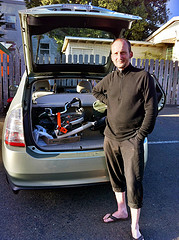
Returning home, I rode to Oakland airport from a Berkeley friend’s home (thanks, M!), checked my bag, gate-checked the folded bike, and rode home from PDX airport as on many past journeys. No special box, case, extra fees, or taxi required.
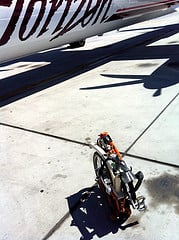
Camping Gear
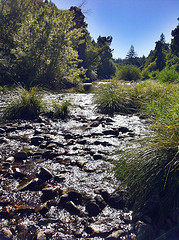
Having modest carrying capacity is a good thing. Otherwise you bring too much. I brought just enough, leaving a little extra space free for food and a bear vault (mandatory in the Lost Coast) purchased along the way.
The niftiest element of my camping kit was the hammock, which replaced a tent and pad, with its underlayment and poles. I used a Hennessy Hammock, the “Deep Jungle Asym” model, with bottom insulation. It’s amazingly compact and light, and I found it far more comfortable than any tent and pad I’ve used. You lay on the diagonal for a nearly straight back, or even on your side, with no pressure points. I packed the sleeping bag inside the hammock in its “snakeskin” sleeves, no separate stuffing. Between this shortcut and only two large centered bags to deal with, I could make and break camp in under five minutes. I was prepared to use the hammock even in absence of well-spaced trees, using the seat pillar of the bike and broad 15″ steel ground stakes for tension and support, but never needed to.
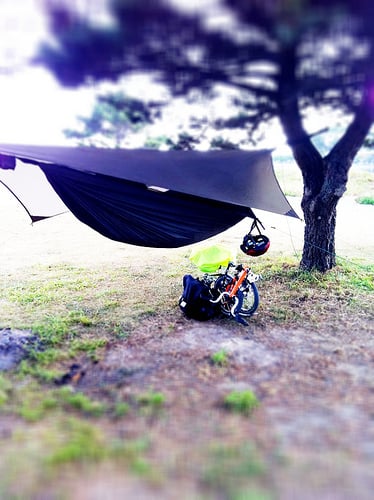
My one big gear regret was packing too light a sleeping bag. I had room for my too-warm down bag, but erred on the side of too cold. Overnight lows were regularly in the 40s. My bag was rated for “survival” into the 30s, but for “comfort” down to only 52F, and I question that rating, at least for a hammock. I couldn’t make up the difference wearing all my wool to sleep. I spent two nights in motels instead of camping in part because the forecast said I’d be shivering in the hours before dawn. Grant Petersen kindly spotted me a vapor barrier liner along the way, and this helped a good deal, but not as much as I’d have liked. O-dark-thirty one morning I made a hot water bottle with trembling hands to ward off a deeper chill.
My cooking capacity was limited to heating water in my two 40oz stainless Klean Kanteens, using a tiny Esbit stove. Thus I avoided needing separate cooking and water stowage vessels. This worked beautifully; you can dump in soupy gruely fixings, and scour them clean by shaking closed with gravel or sand and soapy water.
For bathing, laundry, and general cleanup, I used pine tar soap. Simple and good. I packed several handkerchiefs as washcloths, towels, rags, sweat mops, and nose blowers. No-towel bathing tip: use a credit card or similar as a squeegee on your skin before finishing with a hankie.
An Oregon-made Archival Clothing waxed canvas Flap Musette served admirably as man-purse, holding small high-value items, snacks and toiletries. Strapped to the outside of my front bag underway, it kept its contents dry even after a whole day of rain riding.
I brought at least a dozen small other articles under this heading, but nothing else unusual, and I don’t intend to get that tedious.
Clothing
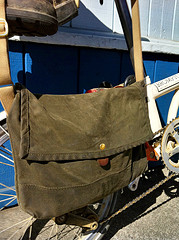
Wool, of course! 3 light Merino tops (2 long, 1 short sleeve), 2 pair of sheer Merino boxers and thick socks, 1 pair of long Merino underwear, 2 pair of worsted wool trousers: one our own Stealth Pantaloons, and one Bicycle Fixation knickers.
I prefer long sleeves and full length pants because I don’t like sunscreen. Makes me break out and seems to attract grime. Even pushing the bike up steeps above 90F in high sun, full coverage lightweight black wool top and bottom kept me as comfortable as anything could have! I think the extra solar radiation absorbed by the black enhances evaporative cooling? Bedouins seem to understand this.
Light wool will dry overnight, or mostly. I washed the trousers only once, more to help appearances than actual stink or discomfort. There were white bands of sweat salt encrusting them. As mentioned above, no “bicycle pants.” The crotch seams of the wool I wore aren’t bulky, and pads seem to me only to trap heat and moisture and press junk up into your junk.
These are the same clothes I wear every day, inside and out, to work, to restaurants, to stack wood. And have for years. All that varies is the number of layers year round. Wool clothing is expensive, you say?
Also waxed leather Blundstone boots, flip-flops for camp, a Tyvek rain shell/windbreaker, and Rainmates chaps. I rode all day one day in chilly rain, wearing most of my layers, and while I ended up quite wet, I stayed toasty.
A floppy hat. Did I mention handkerchiefs?
Food, Supplements, Habits and Health
Severe knee pain has troubled all my longer rides, all my life. That which does not destroy me makes my knees hurt like a mofo. This time it happened too, but far, far milder than in the past, down to a 3 from 8 on a 1-10 scale where 10 is passing out. So determined was I to avoid this pain that I tried several preventive measures all at once. Unfortunately, this scattershot approach means I don’t know which things did the trick. One or more of the following worked for me:
- Fish oil capsules (omega 3 fatty acids play a modulating role in inflammatory response)
- Chia seed (richest plant source of omega 3 fatty acids. A big help in staying fresh, as the fibrous gel matrix draws fluid and fuel deep into your gut for sustained release; water is the first joint lubricant! Lots of antioxidants. I ate chia gruel for most breakfasts and mixed it in canteens for a bubble-tea-like drink. Can you say magnificent well-formed stools?)
- Matcha (powdered green tea. Yet more antioxidants — also just a quick and easy way to get a caffeine pickup, hot or cold. Mixes with chia and Emergen-C or whole milk in canteen…)
- Lots of oily fish, canned, jerky, and fresh, as well as elk and buffalo jerky. In general I ate lots of high-quality fat (=no fry oil), protein, and fiber, and not so much sugar and other carbohydrates. Certainly some sweets and starch, but nothing resembling “carbo-loading.” The chia is said to lower the glycemic index of foods consumed with it. Absolutely I was sometimes very tired, but never felt the classic “bonk” of “not enough sugar!” Overall, energy levels were fantastic. Losing weight wasn’t a goal, but I lost over a pound a day. Somehow I’ve kept it off, too!
- Aleve (naproxen sodium). One morning, one night. After I ran out, I didn’t miss it. But it helped with the first couple days of soreness.
- MRM Joint Synergy supplement and lotion. Contains a dozen ingredients said to support joint health and repel tigers. Clearly, it helps! Cold mornings, when the pain comes creeping in, it rubs the lotion on its skin or else it dissociates again.
- No alcohol. Dehydrates a body! Lowers sleep quality. And I’m sure my liver had better things to do at night.
- “Wrong” pedaling when climbing. Look at your knee with your foot on the pedal in the normal ball-over-spindle position. Move the pedal to the point of peak knee bend. Now move your foot forward at least an inch on the pedal, maybe all the way to the instep. Much less knee bend, even after you drop the saddle a tiny bit to avoid overextension at the opposite point. You can see also that the whole power stroke this way will put the peak stresses at different places than with other foot positions. Distribute the stresses over more area — move your feet around on the pedals! Now, you might quibble that this technique means you don’t use your calf muscles effectively. But that’s just another way of saying you spare your Achilles tendon stress, too. It’s my experience that my bigger muscles can pick up any calf-slack just fine. This is an endurance game, not a sprint. Max power isn’t as important as injury avoidance.
- Don’t be afraid to push the bike. Take a break! Some grades are just so steep and long, and sometimes you’re so tired, that spinning up however slowly can reduce you to far less dignified a state than pushing. Pushing works a whole different set of muscles and joint stress points, and it’s easier than normal walking since you can rest your upper body heavily on the bike. You’ll get back in the saddle soon enough with new energy.
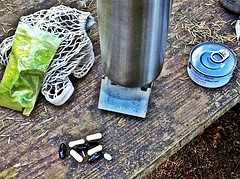
Preparation
Training, schmaining! Obviously I thought a bit about logistics, and I’ve toured in years past along much the same route, using some of the same equipment. But as far as getting my body in shape, I did nothing more than a single 75-mile shakedown ride about three weeks in advance. It left my muscles sore (good), and my cartilage screaming (bad), so I embarked on the dietary and supplement regimen described above.
Most days I ride barely 5 miles. My commute is too short. Portland is, after all, only 8 miles on a side. Only a few days a year typically do I ride more than 20 miles. But this ride, pulling a camping load 50-80 miles every day with significant climbs… I felt great, really great almost every day! The secret? If there is one, it’s that riding even a little bit almost every day, over years, seems to mold one’s being appropriately to ride a lot, even long distances. Confidence and joy in dealing with, say, a flat on your commute, or kids and groceries on your bike, or rush hour traffic, translates directly to confidence and joy in schlepping camping gear on a clown bike hundreds of miles down the interstate, over mountain ranges, into the wilderness.
I’m not athletic — never was. I don’t “exercise,” ever, but I do exercise the birthright of my legs, not abdicating to motors to get me, my kid, and my stuff around town. I’m 44. I “just did it.” And YOU! CAN! TOO! in your one and only life.
Have you read this far? You might enjoy also my 2011 account of a tour out Idaho way, Bromptoneering the Blue and Wallowa Mountains, in which I made some modest gear improvements.
